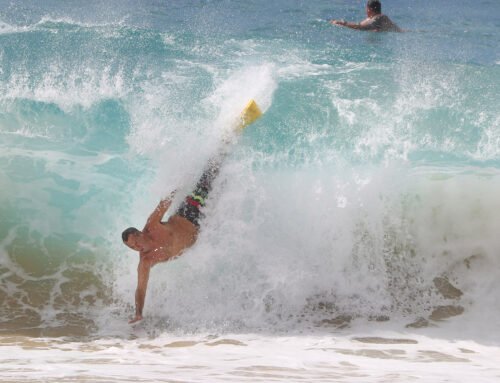Like anything, learning how to fasten a scientific device to the back of a 45-ton humpback in the open Pacific Ocean was a matter of practice. Lammers started years ago with a buoy. He and the crew would talk each other through a hypothetical scenario, motoring close enough to the “whale,” pretending it was surfacing, and just at the right moment, clap the tag on.
When Lammers first started tagging whales, it was a surge of adrenaline. He was hyper aware of every movement. If the boat lurched forward too abruptly, the engine revved, or he swung his pole forward too early, the whale might spook. If too slow, he’d miss his chance entirely. Only after Lammers got the tag on and the whale swam back underwater would he notice his hands were shaking.

In the five years since then, Lammers has tagged dozens of whales as the researcher for the sanctuary, an area managed by the National Oceanic and Atmospheric Administration in partnership with the Hawaii Department of Land and Natural Resources. The 1,370-square-mile area is home to one of the world’s most important humpback whale habitats, where an estimated 10,000 to 12,000 humpbacks travel each year from feeding grounds in northern waters to breed, give birth and nurse their young.

The sanctuary is renowned for its team’s research and efforts to protect humpbacks — in some cases, even saving their lives by untangling them from fishing gear. People come from all over the world to learn how to free the humpbacks, and scientists and students from institutions ranging from the University of Hawaii Hilo to Syracuse University in New York regularly team up to study them with NOAA scientists.
Each whale season, researchers launch about 20 tagging missions, aimed at gaining insight into the whale’s lives and behaviors. But their work is about so much more than just protecting humpbacks.
From Lammers’ perspective, whales serve as ambassadors, reflecting the state of the sea. They teach scientists how human behavior can threaten each fragment of the interconnected ocean environment.

The humpbacks face the consequences of overfishing and climate change, including a warmer and more acidic ocean that threatens vital feeding grounds. During the whales’ 3,000-mile journey to the Hawaiian Islands from Alaska, they navigate the polluted waters of the Pacific Garbage Patch. And once in Hawaii, they deal with heavy vessel traffic, rising ocean noise levels and a barrage of boats shuttling tourists on sunset cruises and snorkel trips.
“We can tell the story of the whole ocean through the eyes of the whale,” Lammers said.

The waters outside of Maalaea Bay can be some of the windiest in the islands, but the sea was like a sheet of glass during the tagging trip last month. Everything was calm — even the whales.
So Lammers and the boat captain, Ted Grupenhoff, patiently waited. It’s just one of the many challenges of tagging humpbacks. Another major one? Retrieving the tag.

Losing a tag is a researcher’s nightmare. There’s the cost — each device is around $14,000. And there’s the data itself — hours of vital information.
The newer tags have GPS, but for a long time scientists had to rely on listening to a radio beacon to locate a tag. You wear a headset, sweep an antenna back and forth across the horizon and listen for beeps.
If the antenna is pointed in the direction of the tag, beeps grow louder. But there are limitations. It doesn’t work if a tag is underwater or picked up by a mariner who decides to stow it in their hull for safekeeping.
One of the first times Lammers tagged a whale — in 2018, shortly after he was hired by NOAA — the device stayed on 37 hours. He thought it was lost, and spent hours driving around Maui, hoping that a higher elevation would give him an unobstructed path to hear beeps.
At his wit’s end, he drove to the highest point on island, the 10,000-foot summit of Haleakala. With his headphones on, he waved the antenna around, drawing the attention of onlookers near the summit viewing area. They became even more confused when they asked what he was listening for and Lammers responded, “Whales!”

But then he heard it. The tag had fallen off in front of Maalaea Boat Harbor, where the research boat is docked. Lammers later learned the tag had slipped under the whale’s body, never reaching the surface to emit a signal.
Other times, tagging in Maui’s coastal waters mean devices left overnight drift out into the channels leading toward the Big Island or Molokai. To retrieve the tag the following day, researchers must brave some of the most treacherous stretches of ocean in the world.
But on the slow days, the crew wishes there was a little more excitement. By midday on this trip, they’d had a few close misses but still no tags on whales.
From the captain’s nest, Grupenhoff searched for spouts. He knew there were whales all around them. What they needed, he began to say, was a “competition pod” — the term used to describe a group of multiple male whales competing for a single female. Competition pods are one of the easiest targets for tagging because the whales, consumed in the challenge, are often distracted.

Even though scientists for decades have known that humpbacks come to Hawaiian waters to reproduce, they have never fully observed a whale giving birth — or mating. Researchers have so many questions: Does it happen in the deep water? Does it happen at night? Do multiple male whales mate with a female, or just one? Someday, through the tagging videos, they might discover the answers.
Grupenhoff steered the boat toward Lahaina to try their luck in that direction. In the distance near the Olowalu coastline, he saw a spout. Then another.
Julia Zeh, another researcher on board, saw them too. She is a doctoral candidate at Syracuse and is working with Lammers this year to tag young whales to understand how they learn to sing. Do they inherently know how, or do they learn over time like human infants who babble?
“That’s a lot of whales!” Zeh called to the captain.






Leave A Comment